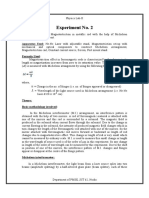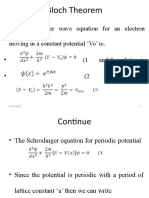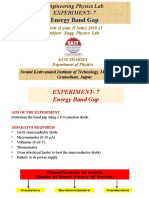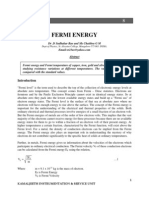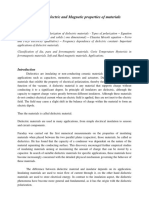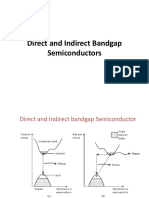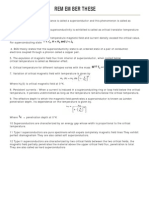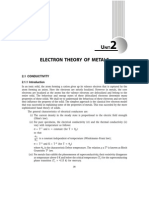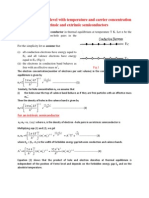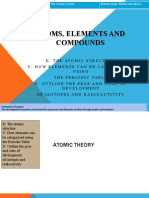Effective Mass
Effective Mass
Uploaded by
agnirailwaysCopyright:
Available Formats
Effective Mass
Effective Mass
Uploaded by
agnirailwaysCopyright
Available Formats
Share this document
Did you find this document useful?
Is this content inappropriate?
Copyright:
Available Formats
Effective Mass
Effective Mass
Uploaded by
agnirailwaysCopyright:
Available Formats
EFFECTIVE MASS OF AN ELECTRON:
A free electron has well defined mass and obeys Newtons law when accelerated by an
external electric field; but when electron is in periodic potential of the crystal lattice, its
behaviour in external electric field is different from that of a free electron. The deviation of
the actual electron behaviour than free electron behaviour may be accounted simply by
considering the electron to have effective mass, m* rather than free electron mass m.
According to wave mechanical theory (de-Broglie) an electron with velocity v is
equivalent to a wave packet moving with group velocity v
g
dK
d
v v
g
e
= = ........................................................................................(1)
where is the angular frequency of de-Broglie wave and K = 2/ is propagation constant.
The energy of particle
e = E
dK
d
dK
dE e
= or ,
dK
dE
dK
d
1
=
e
Now equation (1) gives
dK
dE
v
1
= ................................................................................................ (2)
For free particle,
m
K
m
K
dK
dE
m
K
E
2 2
2 2
2
2
,
2
= = =
Then, from Eqn (2) ] [ ,
2
2
1
2
p
h
As
m
p
m
h
m
K
v = = = =
t
t
This gives linear variation of v with K.
But according to band theory (with periodic potential) of electron, E is not, in general,
proportional to K
2
, there the variation of E with K is as shown in Fig. 5(a). Using this type of
variation of E with K and using equation (2), one can calculate the velocity v, this gives a
curve of the type illustrated as in Fig 5(b). We observe that the velocity of the electron varies
with the slope.
For K=0 and K= t/a, the slope, dE/dK is zero, thus the velocity of the electron is zero at
bottom as well as the top of the first Brillouin Zone.
After K=0, as the value of K increases (i.e., the energy E increases), the velocity increases
reaching its maximum value at K=K
0
where K
0
corresponds to the point of inflection on the
E-K graph. Beyond this point the velocity begins to decrease and finally assumes the zero
value at K=t/a which is the top of the band.
It is significant to note that the decrease of the velocity beyond this point of inflection (with
increase in energy) and its zero value at the top of the band are the entirely new features
which do not appear at all in the behaviour of free electron.
Acceleration and effective mass of electron:
It has been known for a very long time that an electron has a well defined mass, and when
accelerated by an electric field, it obeys Newtonian mechanics. Now, we will discuss the
behaviour of electron when it is to be accelerated inside a crystal due to external electric
field.
When an electric field
e
X
is applied on the electron, then force on electron
e
X e F
=
Work done by electric field over a small distance dx travelled in time dt is
dx eX dE done work
e
= =
Or, ) (vdt eX dE
e
=
,
(Since dx/dt = v)
Substituting value of v from equation (2), we get
dt
dk
dE
eX dE
e
|
.
|
\
|
=
1
, dt
dk
dE eX
dk
dk
dE
e
e
eX
dt
dk
= ............................................................... (3)
Acceleration of electron:
Differentiating eqn (2) with respect to time
|
.
|
\
|
= =
dk
dE
dt
d
dt
dv
a
1
dt
dk
dk
E d
a or .
1
,
2
2
=
Using equation (3) we get,
2
2
2
dk
E d eX
a
e
= -.............................................................................................(4).
When we compare this result with the acceleration of a free electron of mass m i.e.
m
eX
a
e
= ......................................................................................................(5)
Compare eqn. (4) and (5) it follows that an electron in the periodic lattice behaves as an
electron of effective mass m* given by
2
2
2
1
*
1
dk
E d
m
=
Therefore the effective mass of electron:
) 6 ...( .......... .......... .......... .......... .......... .......... .......... .......... .......... *
2
2
2
dK
E d
m
=
Clearly the effective mass of electron is determined by d
2
E/dK
2
and is a function of K. It
indicates the importance of E-K curves for the motion of electron. [(Fig 5(c)] represents the
effective mass (m*) of the electron as a function of K.
The figure shows that the effective mass m* is no longer a strict constant, being now a
function of K. It increases with increase of K, becomes maximum at point of inflexion and
then it becomes negative. The behaviour of the effective mass is as follows
(i) m* is positive in the lower half of the
energy band
(ii) m* is negative in the upper half of the
energy band.
Physically it means since this region is now
close to the top of the band that in upper
half of the band, electron behaves as a
positively charged particle. The negative
mass can be seen dynamically by noting
that the velocity decreases, thus
acceleration negative i.e., opposite to the
applied force, implying a negative mass.
This means that in this region the lattice
exerts such a large retarding force on the
electron that it overcomes the applied force
and produces a negative acceleration. Here
the band behaves as a positively charged
particle referred to as a hole.
(iii) At inflexion points (K=K
0
) in E-K
curves, the effective mass m* becomes
infinite.
For a free electron,
m dk
E d
hence and
m
k
m
k
dK
dE
m
k
E
2
2
2 2 2 2 2
2
2
,
2
= = = =
From equation (6), m
m
m = =
2
2
*
For a free electron m* = m,
But for a periodic potential, m* = m
It may be concluded that all the results of the free electron are correct provided m in each
case is replaced by suitable m
*
. Accordingly energy in periodic potential will be given by
* 2
2 2
m
k
E
=
This is known as the effective mass approximation.
As a summary, in the periodic potential, the electron in the crystal will thus behave
dynamically just like a particle with variable effective mass and the whole effect of the
periodic potential on the motion of the electron is to replace the free electron mass with
proper effective mass.
The degree of freedom of an electron in periodic potential is defined by a factor
2 2
2
* dK
E d m
m
m
f
K
= =
f
K
is a measure of the extent to which an electron in state K is free. If m* is large, i.e. the
electron behaves as a heavy particle. When f
k
= 1, the electron behaves as free particle, Fig.
5(d) represents the plot of f
K
against K. It may be noted that f
K
is positive in the lower half of
the band and negative in upper half.
You might also like
- 6th Central Pay Commission Salary CalculatorDocument15 pages6th Central Pay Commission Salary Calculatorrakhonde100% (436)
- 6th Central Pay Commission Salary CalculatorDocument15 pages6th Central Pay Commission Salary Calculatorrakhonde100% (436)
- Absorption in SemiconductorsDocument24 pagesAbsorption in Semiconductorssanganandan100% (2)
- M. SC Physics I and II Sem Practical ListDocument2 pagesM. SC Physics I and II Sem Practical Listycgoswami17% (6)
- A Dictionary of Electronics and Electrical Engineering 2018Document1,087 pagesA Dictionary of Electronics and Electrical Engineering 2018Prince Danda100% (1)
- Exp No 1 Thickness of WireDocument16 pagesExp No 1 Thickness of WireShubham Sharma100% (1)
- Fermi-Dirac Statistics 1Document27 pagesFermi-Dirac Statistics 1lucky jNo ratings yet
- Notes and Experiment To Verify Malus Law FinalDocument7 pagesNotes and Experiment To Verify Malus Law FinalVivek Singh100% (1)
- Module I Part2Document8 pagesModule I Part2Johns T Moncy100% (1)
- The Deuteron Problem - MISTDocument59 pagesThe Deuteron Problem - MISTAriful Islam Pranto100% (4)
- Experiment No. 2Document7 pagesExperiment No. 2shivansh4shekhar50% (2)
- Laser Beam Divergence (BTech 1st Year Experiment)Document2 pagesLaser Beam Divergence (BTech 1st Year Experiment)Manpreet Singh100% (1)
- EDC Unit-1 (Semiconductor Diode) PDFDocument17 pagesEDC Unit-1 (Semiconductor Diode) PDFSaiKrishna81% (16)
- Method of ImageDocument21 pagesMethod of Images100% (1)
- Lab Report: Experiment-2Document6 pagesLab Report: Experiment-2ayash mohanty100% (1)
- Iit Mains Exam Type Questions of Electrostatics PDFDocument13 pagesIit Mains Exam Type Questions of Electrostatics PDFRupinder Sidhu100% (3)
- Some Solutions of Chapter 2 of Antenna Theory Analysis and Design of BalanisDocument14 pagesSome Solutions of Chapter 2 of Antenna Theory Analysis and Design of BalanisProttoy KadirNo ratings yet
- Richardson EqnDocument3 pagesRichardson Eqnagnirailways100% (1)
- Dielectrics IntroductionDocument4 pagesDielectrics Introductionagnirailways100% (2)
- Verification of Fresnels LawsDocument6 pagesVerification of Fresnels LawsUtkar Sh0% (2)
- Bloch TheoremDocument12 pagesBloch TheoremAhsan MoinNo ratings yet
- Energy Band Gap: Engineering Physics Lab Experiment-7Document24 pagesEnergy Band Gap: Engineering Physics Lab Experiment-7DHRUV JAIN0% (1)
- Babinet Compensator BirefringenceDocument8 pagesBabinet Compensator BirefringenceReddyvari Venugopal100% (2)
- Determination of Wavelength of Light by Newton's Rings MethodDocument2 pagesDetermination of Wavelength of Light by Newton's Rings MethodDipankar Mishra100% (2)
- Experiment 7 Study of V - I Characteristics of Zener Diode and Determine Its Voltage Regulation.Document7 pagesExperiment 7 Study of V - I Characteristics of Zener Diode and Determine Its Voltage Regulation.Tushar SharmaNo ratings yet
- Michelson Interefrometer Viva QuestionsDocument2 pagesMichelson Interefrometer Viva QuestionsDhruv NagarNo ratings yet
- M.SC - pHYSICS - Electrodynamics and Plasma Physics - Paper XVDocument232 pagesM.SC - pHYSICS - Electrodynamics and Plasma Physics - Paper XVTyisil RyanNo ratings yet
- Fermi EnergyDocument6 pagesFermi EnergyReddyvari Venugopal100% (2)
- ElectrostaticsDocument39 pagesElectrostaticsshreyas bulbule100% (1)
- 3.e by M by Thomson MethodDocument4 pages3.e by M by Thomson MethodRavi Kanth M N0% (1)
- Viva Questions PDFDocument4 pagesViva Questions PDFRiya SalujaNo ratings yet
- Numericals Based On Fermi Level and Fermi Distribution FuctionDocument5 pagesNumericals Based On Fermi Level and Fermi Distribution FuctionJag RamNo ratings yet
- Laser & Fiber OpticsDocument34 pagesLaser & Fiber Opticspshantanu123100% (3)
- Viva Questions .. (12th) Term 2Document7 pagesViva Questions .. (12th) Term 2Sandeep kumarNo ratings yet
- Dielectrics Lecture Notes PDFDocument33 pagesDielectrics Lecture Notes PDFGokul Subramanyan100% (1)
- Density of States and Fermi Energy ConceptsDocument25 pagesDensity of States and Fermi Energy ConceptsSwapna BharaliNo ratings yet
- Brewster's Law & Malus' Law ExperimentDocument13 pagesBrewster's Law & Malus' Law ExperimentOm JaiswalNo ratings yet
- 3.ploarization and Types of PolarizationDocument9 pages3.ploarization and Types of PolarizationAshutosh Singh100% (1)
- Physics 12th Full Q&ADocument115 pagesPhysics 12th Full Q&AKiranshree100% (1)
- L6 Scattering PartialWavesDocument19 pagesL6 Scattering PartialWavesdwyphy100% (1)
- Newton's Ring ExperimentDocument3 pagesNewton's Ring ExperimentRoshnee BoseNo ratings yet
- B.Sc. V Semester Physics:: Paper VI (A) Solid State Physics:: Imp QuestionsDocument2 pagesB.Sc. V Semester Physics:: Paper VI (A) Solid State Physics:: Imp QuestionsReddyvari Venugopal100% (1)
- 02 Direct and Indirect Band Gap SemiconductorDocument16 pages02 Direct and Indirect Band Gap SemiconductorAneesh Reddy100% (1)
- Newton's Ring Experiment - 1Document6 pagesNewton's Ring Experiment - 1darshan100% (1)
- CE Input and Output CharacteristicsDocument10 pagesCE Input and Output Characteristicsgirishkumardarisi254No ratings yet
- Dielectric PolarizationDocument2 pagesDielectric PolarizationAhmed Magdy Beshr100% (1)
- Numerical On ElectrostaticsDocument2 pagesNumerical On ElectrostaticsAshok Pradhan0% (1)
- Physics OpticsDocument162 pagesPhysics OpticsLidnu100% (2)
- Question & Answer of SuperconducatorDocument9 pagesQuestion & Answer of SuperconducatorSai Printers100% (3)
- 04-Band Gap - Four Probe MethodDocument7 pages04-Band Gap - Four Probe MethodAryan VermaNo ratings yet
- Stefan's ConstantDocument11 pagesStefan's ConstantPhysics Instruments100% (1)
- Numerical Aperture ExperimentDocument4 pagesNumerical Aperture ExperimentHuman Error (Sid)67% (3)
- Revised-21-22-Final-Compiled MCQ of All Units Semester 2.docx - EditedDocument50 pagesRevised-21-22-Final-Compiled MCQ of All Units Semester 2.docx - Editedsufiyan sheikhNo ratings yet
- Kronig Penney ModelDocument16 pagesKronig Penney ModelPo Kai100% (1)
- Malayaj - PHY321Assignment No. 4Document8 pagesMalayaj - PHY321Assignment No. 4Malayaj MishraNo ratings yet
- Experiment No. 14 Planck's Constant Measuring With FiltersDocument6 pagesExperiment No. 14 Planck's Constant Measuring With FiltersSarveenaNo ratings yet
- Carrier Transport RevisedDocument65 pagesCarrier Transport RevisedShivani GuptaNo ratings yet
- Laser NotesDocument11 pagesLaser NotesRohith0% (1)
- 2.57 Nano-To-Macro Transport Processes Fall 2004: Ikn A IkxDocument7 pages2.57 Nano-To-Macro Transport Processes Fall 2004: Ikn A IkxcaptainhassNo ratings yet
- Electron Thepry of MetalsDocument32 pagesElectron Thepry of MetalsnavarajacseNo ratings yet
- SemiconductorDocument20 pagesSemiconductormdtayyab212121No ratings yet
- Thomson's Cathode Ray Tube LabDocument20 pagesThomson's Cathode Ray Tube LabKunbi SantosNo ratings yet
- EdcDocument135 pagesEdcamartya mukherjeeNo ratings yet
- 2.57 Nano-to-Macro Transport Processes Fall 2004: Ae Be CeDocument7 pages2.57 Nano-to-Macro Transport Processes Fall 2004: Ae Be CecaptainhassNo ratings yet
- Feynman Lectures Simplified 2C: Electromagnetism: in Relativity & in Dense MatterFrom EverandFeynman Lectures Simplified 2C: Electromagnetism: in Relativity & in Dense MatterNo ratings yet
- Variation of Fermi Level in Intrinsic and Extrinsic SemiconductorsDocument5 pagesVariation of Fermi Level in Intrinsic and Extrinsic Semiconductorsagnirailways100% (4)
- E-K Diag, Brillouin ZoneDocument2 pagesE-K Diag, Brillouin Zoneagnirailways67% (3)
- North Sydney Boys High School Year 12 Physics 2022: Assessment Task 2Document13 pagesNorth Sydney Boys High School Year 12 Physics 2022: Assessment Task 2LordJayNo ratings yet
- Cbse PMT 2012Document33 pagesCbse PMT 2012Vishal RamakrishnanNo ratings yet
- University of Cambridge International Examinations General Certificate of Education Advanced LevelDocument24 pagesUniversity of Cambridge International Examinations General Certificate of Education Advanced LevelGaming Core.No ratings yet
- 5 Xray Interactions With MatterDocument2 pages5 Xray Interactions With Matterjr2zuzuarreguiNo ratings yet
- Abstract Book FinalDocument51 pagesAbstract Book FinaliordacheNo ratings yet
- Welcome To Presentation of Electro Dynamic TetherDocument11 pagesWelcome To Presentation of Electro Dynamic Tetherv priyankaNo ratings yet
- Thomas J. McFarlane - Consciousness and Quantum Mechanics PDFDocument12 pagesThomas J. McFarlane - Consciousness and Quantum Mechanics PDFioan dumitrescuNo ratings yet
- The Thermal Stability of The Nitrates and CarbonatesDocument7 pagesThe Thermal Stability of The Nitrates and CarbonatesBryan AliNo ratings yet
- Solved Paper: All India Pre Medical TestDocument10 pagesSolved Paper: All India Pre Medical TestTisha AnantsNo ratings yet
- Unit 2: Display DevicesDocument21 pagesUnit 2: Display DevicesrahulNo ratings yet
- Theremino Spectrometer Sample SpectrumsDocument16 pagesTheremino Spectrometer Sample SpectrumsjvcNo ratings yet
- 6 Chapter Chemical Bonding Short Question With AnswersDocument16 pages6 Chapter Chemical Bonding Short Question With AnswersBilal KhanNo ratings yet
- Einstein's Equation and Wave-Particle DualityDocument12 pagesEinstein's Equation and Wave-Particle Duality8hhznfvp2sNo ratings yet
- What Is Charging by Induction and How Does It Occur? How Can The Results of Charging by Induction Be Predicted and Explained?Document2 pagesWhat Is Charging by Induction and How Does It Occur? How Can The Results of Charging by Induction Be Predicted and Explained?Mico James TrillesNo ratings yet
- College of Nursing, ELEYELE Past Question and AnswersDocument28 pagesCollege of Nursing, ELEYELE Past Question and AnswersAnna ScarNo ratings yet
- Quipper Questions Physical Science 2Document240 pagesQuipper Questions Physical Science 2mehcasacayan530No ratings yet
- Tuning of Band Gap Due To Fluorination of Graphyne and GraphdiyneDocument6 pagesTuning of Band Gap Due To Fluorination of Graphyne and GraphdiyneBedamani SinghNo ratings yet
- DCDocument73 pagesDCCj De PeraltaNo ratings yet
- Atoms, Elements and Compounds g7Document40 pagesAtoms, Elements and Compounds g7Menaga A/P IlangkovanNo ratings yet
- Chemistry Test # 2 (R6) 07-12-13Document1 pageChemistry Test # 2 (R6) 07-12-13Qaisar RiazNo ratings yet
- Aether & MatterDocument410 pagesAether & MatterDawne_Berry100% (4)
- Physical Sciences P1 May-June 2016 EngDocument19 pagesPhysical Sciences P1 May-June 2016 Engthembekilethusi9No ratings yet
- GR 9 ICSE Final Exam Question Paper PhysicsDocument4 pagesGR 9 ICSE Final Exam Question Paper PhysicsanjalimenonNo ratings yet
- 99 Gravriljuk - HighNitrogenSteels PDFDocument387 pages99 Gravriljuk - HighNitrogenSteels PDFharoldopintoNo ratings yet
- Chapter No 4Document27 pagesChapter No 4Moin KhanNo ratings yet
- Btech 1 Sem Engineering Physics Kas101t 2022Document2 pagesBtech 1 Sem Engineering Physics Kas101t 2022Ujjwal GargNo ratings yet
- Alison Electrical CourseDocument33 pagesAlison Electrical CourseJulius Ecomu0% (1)
- Electromagnetic Radiation Principles Electromagnetic Radiation PrinciplesDocument69 pagesElectromagnetic Radiation Principles Electromagnetic Radiation PrinciplesFahad AhmedNo ratings yet









